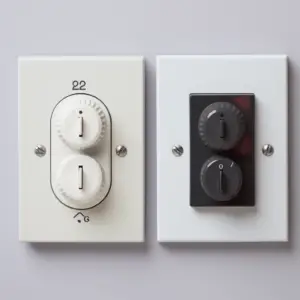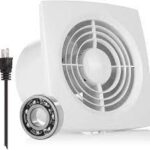Double pole and single pole thermostats are both line voltage thermostats that control resistance, radiant or convection heaters. The difference between the two types of voltage thermostats is offsetting. Double pole thermostats have true offsetting. On the other hand, single pole thermostats don’t have offsetting.
That might not be a big deal to some individuals, but it’s always important to consider various security implications.
Table of Contents
Can I Use a Double Pole Thermostat as a Single Pole?

The biggest concern is; can I use a double pole thermostat as a single pole thermostat?
Yes, you can use a two-pole thermostat as a single-pole thermostat.
A single pole thermostat comprises two black wires. On the other hand, double pole thermostats have two black and two red wires. One red and one black wire are switched, and the other black and red are hot. Two blacks of a single pole are connected to the corresponding two blacks in the box. One of those is hot, and the other alternative serves as the power to the heaters.
If you want to connect the two black and two red wires of double pole thermostats to use as a single thermostat, you should connect them to the two blacks in the box. Take two wires off the heater and separate them. Attach 1 wire to the switch side and black wires to the top of the thermostat.
Furthermore, if you want your connection to last long and be safe, consider hiring a professional technician who will help you get the work done correctly within a very short time.
How Double Pole Thermostats Work
Double pole thermostats also referred to as two-pole thermostats control line voltage heating systems.
Installing double pole thermostats might be challenging since the connection needs at least four wires. However, unlike a single-pole thermostat, a heater may be fully detached from your electrical system.
Power stealing is unnecessary because the double pole thermostat has a dedicated L2 (N) connection. Therefore, a real “off” setting exists on double pole thermostats.
Since there is no power stealing required to operate the double pole thermostat, that promotes energy efficiency and comfort. Double pole thermostats with a dial also feature an “off” setting.
A twin pole thermostat could be necessary for some electrical systems. Therefore, unless instructed to do so by a licensed electrician, it’s not advisable to replace a double pole thermostat with a single pole device.
How Single Pole Thermostats Work
A single switch on a single pole thermostat activates or stops the heating circuit. The heater’s power flow is stopped when the circuit is opened. While the heater still has the electricity to control the room’s temperature, the circuit is closed. A thermostat achieves its control signal in this manner.
When a thermostat is in the open (or “off” setting), a voltage from the L2 or neutral (N) wire of the electrical panel is still maintained at the heater. However, in this case, no current and hence no power is generated.
Any single pole thermostat that is not dial-based often employs a power stealing device. Since the thermostat has two replaceable wires, installation is simplified. That does have certain disadvantages, though.
The main concern is that two-wire single pole thermostats frequently have to turn on or off the heater to maintain power for the thermostat. As a result, single pole thermostats lack a setting that is completely “off.”
As a result, the thermostat may slightly overheat a room when it is not needed, which lowers energy efficiency. Although they don’t use power stealing, single pole dial thermostats still offer the lowest temperature setting.
Another downside is that a single pole thermostat would need to switch off a heater occasionally unnecessarily. That lowers the heater’s output, ultimately affecting how comfortable your house feels.
Do I Need a Double Pole Thermostat or a Single Pole Thermostat?
Energy consumption is the main factor when deciding whether you need a double pole or single pole thermostat.
Saving electricity by setting your thermostat to “low” was cheaper than turning it on and off. Turning off your heating while not in use saves more electricity.
If you use a single pole thermostat, you will need to remove your heater or cut the main power supply to totally turn it off. Additionally, even with the thermostat set to its lowest level, the heater will operate if the temperature in the room drops.
When you don’t need to use the heater anymore, all you have to do is switch it off using a double pole thermostat and press the “off” button.
Your power source may be outdoors or hard to reach on your panel box. If so, you may prefer a wall-mounted thermostat to conveniently access the “off” option.
What is The Difference Between Double Pole and Single Pole Thermostat?

It’s a low setting on single pole thermostats, which many people mistake for offsetting. In other words, the heaters will start working when the temperature falls below a certain point, which is often 45 degrees Fahrenheit.
A double pole stat has been completely twisted off and won’t switch on, even if the house temperature drops below 45 degrees.
That brings up a crucial point that people should keep in mind: keep objects away from heaters and avoid turning them directly on them.
Although you should always be aware of heater clearance requirements, single pole thermostats make this more crucial since your heater will turn on automatically when the air temperature dips below a set level.
In certain circumstances, people may spend months without using a heater (particularly in the summer), but heaters will automatically kick on when the first freeze arrives.
Items put on the baseboard might cause unpleasant things to occur. The most straightforward approach to ensure that a heater is off is to turn off the power to the heater circuit at the main panel.
The thermostat should be removed from the wall and the heater breaker turned off, says Cadet Vice President of Engineering Craig Peterson. This detects single- or double-pole thermostats. Two wires behind a pole indicate a single pole. Four wires are a double pole. If your thermostat has more than four wires, one is typically low voltage and controls a central furnace, boiler, or similar device.


